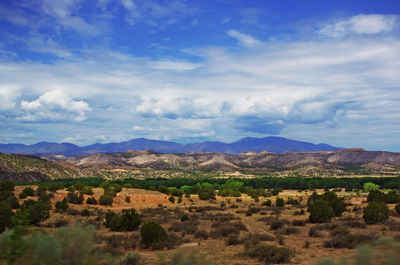New Mexico Economy
Agriculture and Industry in New Mexico
New Mexico economy is a set of human and social activities and institutions related to the production, distribution, exchange and consumption of agriculture and industry goods and services. The balance between New Mexico various economic sectors differs largely between various regions and other states in the US.New Mexico Agriculture and Industry
New Mexico's real gross state product in 2012 was estimated to be $70,699 which was $116,741 and 62% lower than the national state average, $187,440. New Mexico has the 38th highest GSP out of the 50 states.
Agriculture provides a considerable source of income for New Mexico. The most important agricultural industry is ranching. Ranches throughout the state make use of land that is too steep or too rocky for growing crops. Cattle and sheep thrive on the open range year round. Major crops of hay and sorghum are grown in the dry climate. Pinto beans, piñon nuts, and chili peppers are also raised.
New Mexico's mineral wealth includes natural resources used for energy production. Reserves of natural gas, uranium, petroleum, and coal are found here. Large amounts of potash - a fertilizer material - are mined as well as manganese, copper, silver, and turquoise.
New Mexico's beautiful country, national forests, and historic sites make it an attractive destination for tourists. The tourism industry is a significant source of income for the state.
More than 25% of New Mexico's residents work for the federal government at air force bases, national observatories, and laboratories throughout the state. The temperate climate and growing population continue to attract many new manufacturing industries to the state, especially those related to the defense industry.
New Mexico Agriculture:
Cattle, dairy products, hay, nursery stock, chilies.
New Mexico Industry:
Electric equipment, petroleum and coal products, food processing, printing and publishing, stone, glass, and clay products, tourism.
The Bureau of Economic Analysis estimates that New Mexico's total state product in 2003 was $57 billion. Per capital personal income in 2003 was
$24,995, 48th in the nation.
New Mexico Industries by 2004 Taxable Gross Receipts (000s)
Retail Trade 12,287,061
Construction 5,039,555
Other Services (excluding Public Administration) 4,939,187
Professional, Scientific and Technology Services 3,708,527
Accommodation and Food Services 2,438,460
Wholesale Trade 2,146,066
Health Care and Social Assistance 1,897,471
Utilities 1,654,483
Mining and Oil and Gas Extraction 1,238,211
Manufacturing 926,372
Information and Cultural Industries 849,902
Unclassified Establishments 725,405
Real Estate and Rental and Leasing 544,739
Finance and Insurance 254,223
Transportation and Warehousing 221,457
Public Administration 159,013
Educational Services 125,649
Arts, Entertainment and Recreation 124,017
Admin & Support, Waste Management & Remediation 73,062
Agriculture, Forestry, Fishing and Hunting 71,853
Management of Companies and Enterprises 48,714
--------------------------------------------------------------------------------
Totals 39,473,429
Source: State of New Mexico Department of Labor
Cattle and dairy products top the list of major animal products of New Mexico. Cattle, sheep, and other livestock graze most of the arable land of
the state throughout the year.
Limited but scientifically controlled dryland farming prospers alongside cattle ranching. Major crops include hay, nursery stock, pecans, and chile
peppers. Hay and sorghum top the list of major dryland crops. Farmers also produce onions, potatoes, and dairy products. New Mexico specialty crops
include piñon nuts, pinto beans, and chiles.
In the desert and semiarid portions of the state, the scant rainfall evaporates rapidly, generally leaving insufficient water supplies for large-scale
irrigation. The Carlsbad and Fort Sumner reclamation projects on the Pecos River and the nearby Tucumcari project provide adequate water for limited
irrigation in those areas. Located upstream of Las Cruces, the Elephant Butte Dam and Reservoir provides a major irrigation source for the extensive
farming along the Rio Grande. Other irrigation projects use the Colorado River basin and the San Juan River.
Lumber mills in Albuquerque process pinewood, the chief commercial wood of the rich timber economy of northern New Mexico.
New Mexicans derive much of their income from mineral extraction. Even before European exploration, Native Americans mined turquoise for making jewelry,
and later silver [4]. New Mexico produces uranium ore, manganese ore, potash, salt, perlite, copper ore, beryllium, and tin concentrates. Natural gas,
petroleum, and coal are also found in smaller quantities.
Industrial outputs, centered around Albuquerque, include electric equipment; petroleum and coal products; food processing; printing and publishing;
and stone, glass, and clay products. Defense-related industries include ordnance. Important high-technology industries include lasers, data processing,
and solar energy.
Federal government spending is a major driver of the New Mexico economy; and provides more than a quarter of the state's jobs. Many of the federal
jobs relate to the military; the state hosts three air force bases (Kirtland Air Force Base, Holloman Air Force Base, and Cannon Air Force Base), a
testing range (White Sands Missile Range), an army proving ground and maneuver range (Fort Bliss Military Reservation - McGregor Range) national observatories,
and the technology labs of Los Alamos National Laboratory (LANL) and Sandia National Laboratories (SNL). SNL conducts electronic and industrial research
next to Kirtland AFB, on the southeast side of Albuquerque. These installations also include the missile and spacecraft proving grounds at White Sands.
In addition to the military employers, other federal agencies such as the National Park Service, the United States Forest Service, and the United States
Bureau of Land Management are a big part of the states rural employment base.
Virgin Galactic, the first company to develop commercial flights into space, has decided to put its world headquarters and mission control is southern
New Mexico (25 miles south of Truth or Consequences).
Tourism provides many service jobs. For top attractions see: Tourism.
The private service economy in urban New Mexico has boomed in recent decades. Since the end of World War II Albuquerque has gained an ever-growing
number of retirees, especially among armed forces veterans and government workers. The city is also increasingly gaining notoriety as a health conscious
community, and contains many hospitals and a high per capita number of massage and alternative therapists. The warm, semiarid climate has contributed
to the exploding population of Albuquerque, attracting new industries to New Mexico. By contrast, many heavily Native American and Hispanic rural communities
remain economically underdeveloped.

US economy is relies on private decision-making ("economic freedom")




